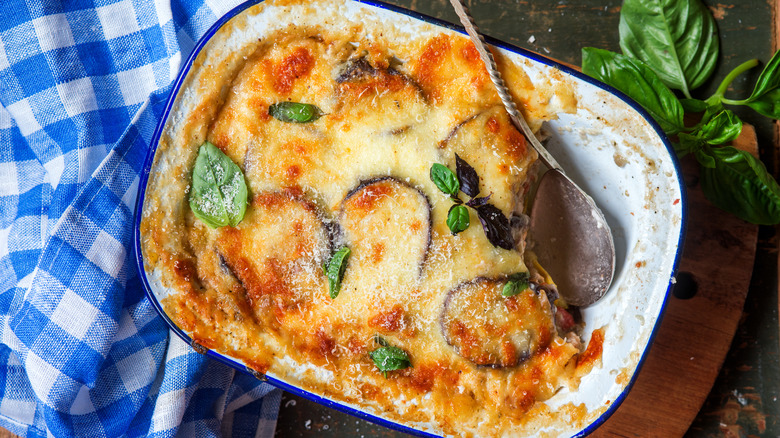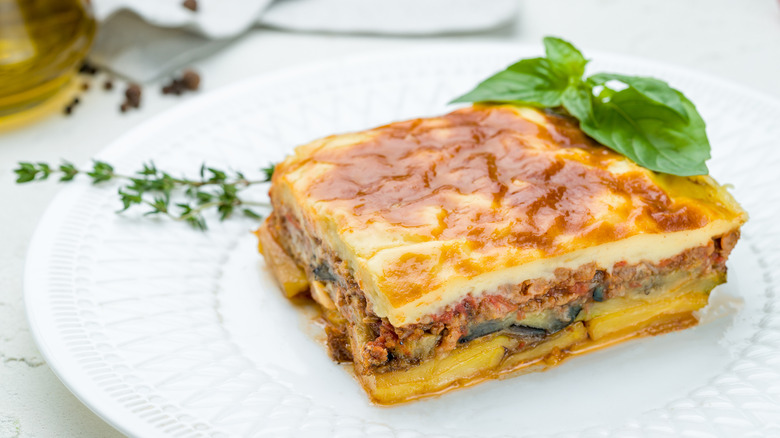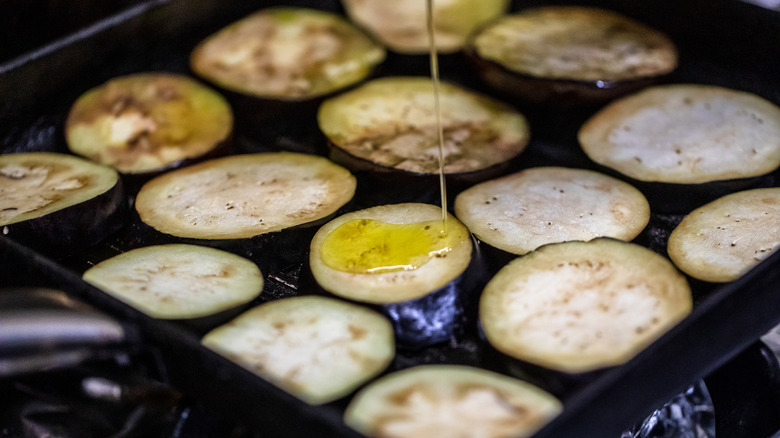What Makes Moussaka Unique?
Those food lovers who've made it into Greek restaurants, eating their way through the country, or had it on the dinner table while growing up at home, know how truly rich and flavorful Greek food can be. Even Gordan Ramsey himself expressed how he preferred great Greek food to other cuisines (via Insider).
Greek food consistently showcases how ripe vegetables, hearty red meat, and fresh herb seasoning can make for a phenomenal meal. And if any or all of those concepts sound good to you, we highly encourage you to try Greece's most famous casserole: the moussaka (via My Greek Dish). Moussaka, pronounced "moo-saa-kuh," is like no casserole you've had before. Unlike American casserole recipes, which usually rely on some kind of carb to carry the dish, moussaka is made using a base of eggplant and is the perfect blend of rich and savory flavors to really make a show-stopping dish when prepared correctly.
What is moussaka?
Moussaka is one of Greece's many heartwarming, nostalgic, belly-filling recipes. If you are looking for a great dish to bake up on a cold day, or a truly hearty meal, you won't have to look much further than this Greek, meat and veggie casserole. My Greek Dish describes moussaka as a baked dish layered with eggplants and potatoes, coated with meaty tomato sauce, followed by a second coating of bechamel sauce.
There are quite a few different ways to make moussaka. Everyone has their own way of doing things. In fact, people always have an opinion as to whether beef or lamb should be used or if potatoes should even be allowed in the dish. But for the most part, The Mediterranean Dish says that this Greek classic is made by slicing, salting, and then broiling large eggplants before building the moussaka. Once your eggplant is prepared, you can decide whether or not you want to use sliced potatoes (if you do use russet or Idaho potatoes) and from there layer up the veggies with your meat gravy and top it off with a creamy bechamel sauce. This recipe may seem like it's swimming in liquid, but after baking, this dish becomes the comfort food of the century with creamy, meaty, and hearty veggie flavors all layered into one pan.
The history of moussaka
Greece, like many European countries, has had its traditional cuisine transformed over time by outside forces and adopted many of its favorite dishes from its diverse neighbors, according to Fly Me To The Moon Travel. Any traditional dish that has been passed over several generations of hands have tweaked and adapted the recipe to fit their needs, and the moussaka is no exception. While moussaka is a Greek favorite, it is also eaten and enjoyed by other countries around the Balkan nations, Turkey, and the Middle East. Today most variations of the moussaka consist of eggplant and ground meat.
As for how the Greeks received this dish, Nosta says that thanks to a 13th-century Baghdad cookbook published in the Levant, it is believed that Arabian migrants introduced moussaka to the country. However, at that time it seemed more like a stew than a casserole. Then in the early 20th century, Greek recipe writer and chef, Nikolaus Tselementes, re-wrote the moussaka into what we recognize today. He pushed the recipe to consist of layers and added bechamel sauce to the top of the dish.
It's all in the ingredients needed
Moussaka is made of three major components: eggplant, meat sauce, and bechamel sauce. Now when you research moussaka recipes, like the one offered by Cooking Gorgeous, the dish suggests slicing potatoes to use as an additional layering component, along with the eggplant. That being said, the oldest recipe for moussaka dates back to the 13th century (via Nosta), but Europeans didn't have access to potatoes until the mid-16th century (per Berlin Experiences). So, odds are the original moussaka didn't use potatoes, but potatoes do pair excellently with the meat and creamy characteristics of this dish.
One could say that the moussaka is a particularly saucy meal. Between the layers of veggies, RecipeTin Eats says that moussaka must have a thick tomato-based meat sauce using either lamb or beef and flavored with traditional flavors, like oregano and cinnamon, to make it taste extra rich. When baked this sauce will solidify a little more and pair perfectly with the bechamel sauce, which Food Network lists as being made from warmed butter, flour, milk, egg yolks, goat cheese, and a variety of seasonings. Overall, many would agree that the spices and sauces make this dish unique (via My Greek Dish).



